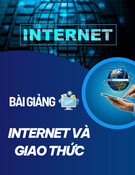
http://www.iaeme.com/IJM/index.asp
68
editor@iaeme.com
International Journal of Management (IJM)
Volume 8, Issue 2, March – April 2017, pp.68–76, Article ID: IJM_08_02_008
Available online at
http://www.iaeme.com/ijm/issues.asp?JType=IJM&VType=8&IType=2
Journal Impact Factor (2016): 8.1920 (Calculated by GISI) www.jifactor.com
ISSN Print: 0976-6502 and ISSN Online: 0976-6510
© IAEME Publication
CORRELATING INTERNET OF THINGS
Kaleel Ahmed A
Research Scholar, Bharath University, Chennai, India
Prof. Dr. C.B. Senthil Kumar
Department of Commerce, Dr. M.G.R Educational and Research Institute University,
Maduravoyal, Chennai, India
ABSTRACT
As objects become embedded with sensors and gain the ability to communicate,
the new information networks promise to create new business models, improve
business processes, and reduce costs and risks. One such Model is the internet of
things. Sensors and actuators are embedded in physical objects from roadways to
pacemakers are linked through wired and wireless networks, often using the same Internet
Protocol (IP) that connects the Internet. Internet of Things has great potential to support
society, to improve energy efficiency and to optimize various kinds of mobility and
transport at the same time. However, the Internet of Things raises significant
challenges that could stand in the way of reaping its potential benefits. Pitfalls
concerning cyber security, theft and hacking of personal and financial data are the
ones that are making people agitated.
Electronic devices used at home, workplaces, in a neighbourhood or in a large
urban landscape are connected and provide data which is accumulated and analyzed
for the benefit of its users. The ability of a simple cell phone connecting to other
devices, sensors in public, to regulate traffic and other civic institutions, shows how
IoT has merged with data and analytics of data plays a key role and will continue to
do so in the future.
Key words: Internet of Things (IoT), Connected, Mobility, Cyber Security,
Accumulated, Civic Institutions, Merged
Cite this Article: Kaleel Ahmed A and Prof. Dr. C.B. Senthil Kumar, Correlating
Internet of Things. International Journal of Management, 8 (2), 2017, pp. 68–76.
http://www.iaeme.com/IJM/issues.asp?JType=IJM&VType=8&IType=2
1. INTRODUCTION
Kevin Ashton, co-founder and executive director of the Auto-ID Centre, is credited with
coining the term the Internet of Things “empowering computers with their own means of
gathering information, so they can see, hear and smell the world for themselves, in all its
random glory."

Correlating Internet of Things
http://www.iaeme.com/IJM/index.asp 69 editor@iaeme.com
SAP’s Research’s Stephan Haller defined the Internet of Things as "a world where
physical objects are seamlessly integrated into the information network, and where the
physical objects can become active participants in business processes."
As broadband internet is more widely available, the cost of connecting is decreasing, more
devices are being created with Wi-Fi capabilities and sensors built into them. The cost of
technology is going down and smartphone usage is increasing at a fast rate. These factors
have created a perfect storm for the “Internet of things” Technology companies have been
trying to develop new ways to link the Internet with physical objects.
The advancement of IoT has led to a rise in cloud computing which leverages remote,
networked computing resources to process, manage, and store data, advancement in data
analytics with new algorithms and rapid increases in computing power, data storage, and
cloud services which provide new opportunities for extracting information and knowledge.
A number of companies and research organizations have offered a wide range of
projections about the potential impact of IoT on the Internet and the economy during the next
five to ten years. Cisco projects that by 2020; there could be 50 billion devices that can
connect to the internet. Morgan Stanley, however, projects 75 billion networked devices by
2020.
2. APPLICATIONS
The underlying concept behind Internet of Things (IoT) is far from new. Companies have
been using sensors and networks to provide a steady stream of information about where
devices are, how they’re being used, their condition, and the state of their environment for
more than 20 years. One of the earliest applications of such technology has been in the area of
energy optimization: sensors deployed across the electricity grid can help utilities remotely
monitor energy usage and adjust generation and distribution flows.
The growth in mobile devices and the broad availability of wireless connectivity is now
driving IoT to the forefront. Other factors include the emergence of the cloud as a way to
store and process large volumes of data cost-effectively, and the rapid deployment of
analytics technologies that enable enterprises to manage and extract useful information from
large volumes of data, quickly and cost-effectively.
Some of the simple ways in which Internet of Things can create value are:
2.1. Smart Home
Smart Home clearly stands out, ranking as highest Internet of Things application on all
measured channels. More than 60,000 people currently search for the term “Smart Home”
each month. This is not a surprise. The IoT Analytics company database for Smart Home
includes 256 companies and startups. More companies are active in smart home than any
other application in the field of IoT. The total amount of funding for Smart Home startups
currently exceeds $2.5bn. This list includes prominent startup names such as Nest or AlertMe
as well as a number of multinational corporations like Philips, Haier, or Belkin.
There are challenges companies faces that operate in this space:
• For manufacturers of consumer electronics and hardware, there is a difficulty in creating
distinctive features that could increase margins and a lack of brand loyalty in an immature
market.
• For Telecom and cable providers a connected home competes with existing high margin
products.
• For retail outlets, the challenge of building sales force capability and complexity of value
proposition that needs to be communicated to customers.

Kaleel Ahmed A and Prof. Dr. C.B. Senthil Kumar
http://www.iaeme.com/IJM/index.asp 70 editor@iaeme.com
• At home, the emphasis is on ease of use and to help people lead more comfortable lives. Smart
homes filled with connected products are loaded with possibilities to make our lives easier,
more convenient, and more comfortable. An example of this is Alexa, the voice assistant on
the Amazon Echo. One can ask Alexa to either read that days’ news or if while cooking can
read you a specific recipe. This device and the like are simple but powerful as they are
connected to th world wide web.
• BI Intelligence, the research arm of Business Insider expects the number of smart home
devices shipped will grow from 83 million in 2015 to 193 million in 2020. This includes all
smart appliances (washers, dryers, refrigerators, etc.), smart home safety and security systems
(sensors, monitors, cameras, and alarm systems).
• The most obvious benefit to smart homes is convenience, as more connected devices can
handle more operations (lighting, temperature, etc.) and frees up the resident to perform other
tasks. Beyond this, smart home devices can help reduce costs and conserve energy.
The following are some examples of IoT devices:
• As stated above the most recent is the Amazon Echo. The device functions as a central hub for
your other smart home gadgets. It has a voice activated assistant Alexa for other tasks.
• Nest, a home device manufacturer created a learning thermostat that can automatically adjust
temperature based on ones location and uses a farfield sensor to determine the time and
temperature from a distance.
• The August smart lock provides enhanced security for the home. When it comes to everyday
personal use, wearables such as Fitbits and Apple watches are the most common and popular.
• An office space or office building is also impacted by smart devices. For example, Cisco
controls the core functions of its 300 buildings worldwide, including climate, electricity use
and security, from four locations.
2.2. Wearables
Wearables remains a hot topic too. As consumers await the release of Apple’s new smart
watch in April 2015, there are plenty of other wearable innovations to be excited about: like
the Sony Smart B Trainer, the Myo gesture control, or Looksee bracelet. Of all the IoT
startups, wearables maker Jawbone is probably the one with the biggest funding to date. It
stands at more than half a billion dollars!
2.3. Smart City
• Smart city spans a wide variety of use cases, from traffic management to water distribution, to
waste management, urban security and environmental monitoring. Its popularity is fueled by
the fact that many Smart City solutions promise to alleviate real pains of people living in cities
these days. IoT solutions in the area of Smart City solve traffic congestion problems, reduce
noise and pollution and help make cities safer. In the city of Santander in Spain, the IoT is
helping motorists. The local officials and government have embedded around four hundred
sensors in the city center. These register which parking spaces are free or occupied and
transmit this information to the cloud via wireless network. It can then direct motorists to the
next available parking space.
• In Amsterdam, data was used in waste collection. The city equipped more than 2000 waste
bins with sensors. These monitor the fill level and report to the central system. Hence, the
waste disposal companies know exactly when a bin needs to be emptied. Instead of regular
intervals, they now only collect the waste on demand, cutting down on time spent emptying
half-full bins.
• In the Czech Republic, the Rodos Transport Systems Development Center has developed a
complex mobility model. This helps in advising police, fire departments and rescue services
for planning and holding major events.

Correlating Internet of Things
http://www.iaeme.com/IJM/index.asp 71 editor@iaeme.com
2.4. Smart Grids
Smart grids are a special one. A future smart grid promises to use information about the
behaviors of electricity suppliers and consumers in an automated fashion to improve the
efficiency, reliability, and economics of electricity. 41,000 monthly Google searches highlight
the concept’s popularity. However, the lack of tweets (Just 100 per month) shows that people
don’t have much to say about it.
2.5. Industrial Internet
The industrial internet is also one of the special Internet of Things applications. While many
market researches such as Gartner or Cisco see the industrial internet as the IoT concept with
the highest overall potential, its popularity currently doesn’t reach the masses like smart home
or wearables do. The industrial internet however has a lot going for it. The industrial internet
gets the biggest push of people on Twitter (~1,700 tweets per month) compared to other non-
consumer-oriented IoT concepts.
2.6. Connected Car
The connected car is coming up slowly. Owing to the fact that the development cycles in the
automotive industry typically take 2-4 years, we haven’t seen much buzz around the
connected car yet. But it seems we are getting there. Most large auto makers as well as some
brave startups are working on connected car solutions. And if the BMWs and Fords of this
world don’t present the next generation internet connected car soon, other well-known giants
will: Google, Microsoft, and Apple have all announced connected car platforms.
2.7. Connected Health (Digital health/Telehealth/Telemedicine)
Connected health remains the sleeping giant of the Internet of Things applications. The
concept of a connected health care system and smart medical devices bears enormous
potential (see our analysis of market segments), not just for companies also for the well-being
of people in general. Yet, Connected Health has not reached the masses yet. Prominent use
cases and large-scale startup successes are still to be seen. Might 2015 bring the
breakthrough?
2.8. Smart Retail
Proximity-based advertising as a subset of smart retail is starting to take off. But the
popularity ranking shows that it is still a niche segment. One LinkedIn post per month is
nothing compared to 430 for smart home.
2.9. Smart Supply Chain
Supply chains have been getting smarter for some years already. Solutions for tracking goods
while they are on the road, or getting suppliers to exchange inventory information have been
on the market for years. So while it is perfectly logic that the topic will get a new push with
the Internet of Things, it seems that so far its popularity remains limited.
2.10. Smart Farming
Smart farming is an often overlooked business-case for the internet of Things because it does
not really fit into the well-known categories such as health, mobility, or industrial. However,
due to the remoteness of farming operations and the large number of livestock that could be
monitored the Internet of Things could revolutionize the way farmers work. But this idea has
not yet reached large-scale attention. Nevertheless, one of the Internet of Things applications

Kaleel Ahmed A and Prof. Dr. C.B. Senthil Kumar
http://www.iaeme.com/IJM/index.asp 72 editor@iaeme.com
that should not be underestimated. Smart farming will become the important application field
in the predominantly agricultural-product exporting countries.
3. OPPORTUNITIES OF INTERNET OF THINGS
There is a lot of potential to be tapped into with regards to the Internet of things:
3.1. B2B Value
Much of the coverage on internet of things is focused on consumer application – wearables
and smart homes with automated products. However there is an opportunity to highlight and
exploit business-to-business application which account for almost 70% of the value the will
be generated from B2B IoT services over the next ten years.
3.2. Operations
Investing in IoT hardware such as sensors built in equipment and products is the first step.
Creating new business value comes from optimizing operations. In factories, sensors will
provide a flow of data to optimize workflows and make processes more efficient.
3.3. New Business Models
IoT makes certain business models possible. For example, the ability to track when and how
physical assets are actually used allows providers to price and charge for use.
The largest, most sophisticated corporations struggle to make the most of IT. Investing in
IoT is both strategic and operational for a company. It gives the ability to capture, analyze,
and act on the data that can be collected. This requires not only sophisticated technology, but
also an organization that can share data and management that is ready to make data-driven
decisions. A company will need to learn how to interpret real-time data and will need to share
their data.
3.4. Challenges Faced
With all the benefits of IoT, there are also considerable risk involved as the increase in
connected devices gives hackers and cyber criminals more entry points. Aside from the
security issues, there is the need for privacy which an average consumer is concerned about.
There are some challenges with regards to the Internet of things:
3.5. Aligning Organization
The adoption of IoT will force a company to modify traditional organizational roles as
information technology becomes widely embedded across assets, inventories, and operations.
As a result, companies will have to align their IT and operational leadership.
3.6. Security Imperative
Implementing the Internet of Things brings the issue of cyber security to the forefront. IoT
poses not only the normal risks associated with the increased use of data but also the vastly
greater risks of systemic breaches.
One of the biggest challenges for companies that hope to capitalize on the Internet of
things is protecting company and customer data. A range of IoT-based applications depend on
access to consumer data, including data collected passively from customers’ behavior. One
example of this is in the retail industry with a fully automated checkout. Customers can walk
out the door of a store without having to wait on line or even swipe a card. Owing to this,

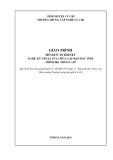

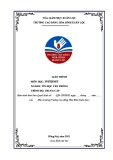
![Bài giảng Internet và giao thức: Chương 5 - TS. Nguyễn Chiến Trinh [Chuẩn SEO]](https://cdn.tailieu.vn/images/document/thumbnail/2024/20240701/thuyduong0906/135x160/1511719824961.jpg)

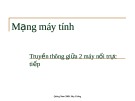
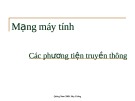
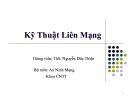
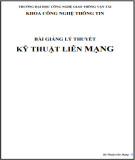
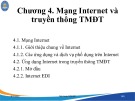

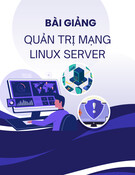
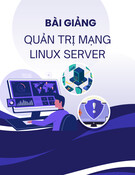

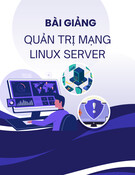
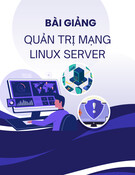
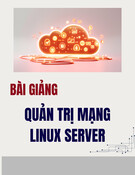
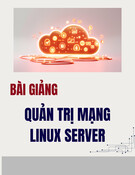

![Đề thi cuối kì Nhập môn Mạng máy tính: Tổng hợp [Năm]](https://cdn.tailieu.vn/images/document/thumbnail/2025/20251110/nminhthoi53@gmail.com/135x160/38281762757217.jpg)
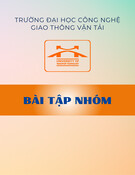
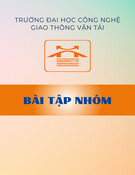
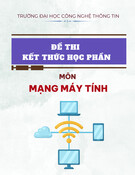
![Đề thi học kì 2 môn Nhập môn Mạng máy tính [kèm đáp án]](https://cdn.tailieu.vn/images/document/thumbnail/2025/20251014/lakim0906/135x160/23811760416180.jpg)
